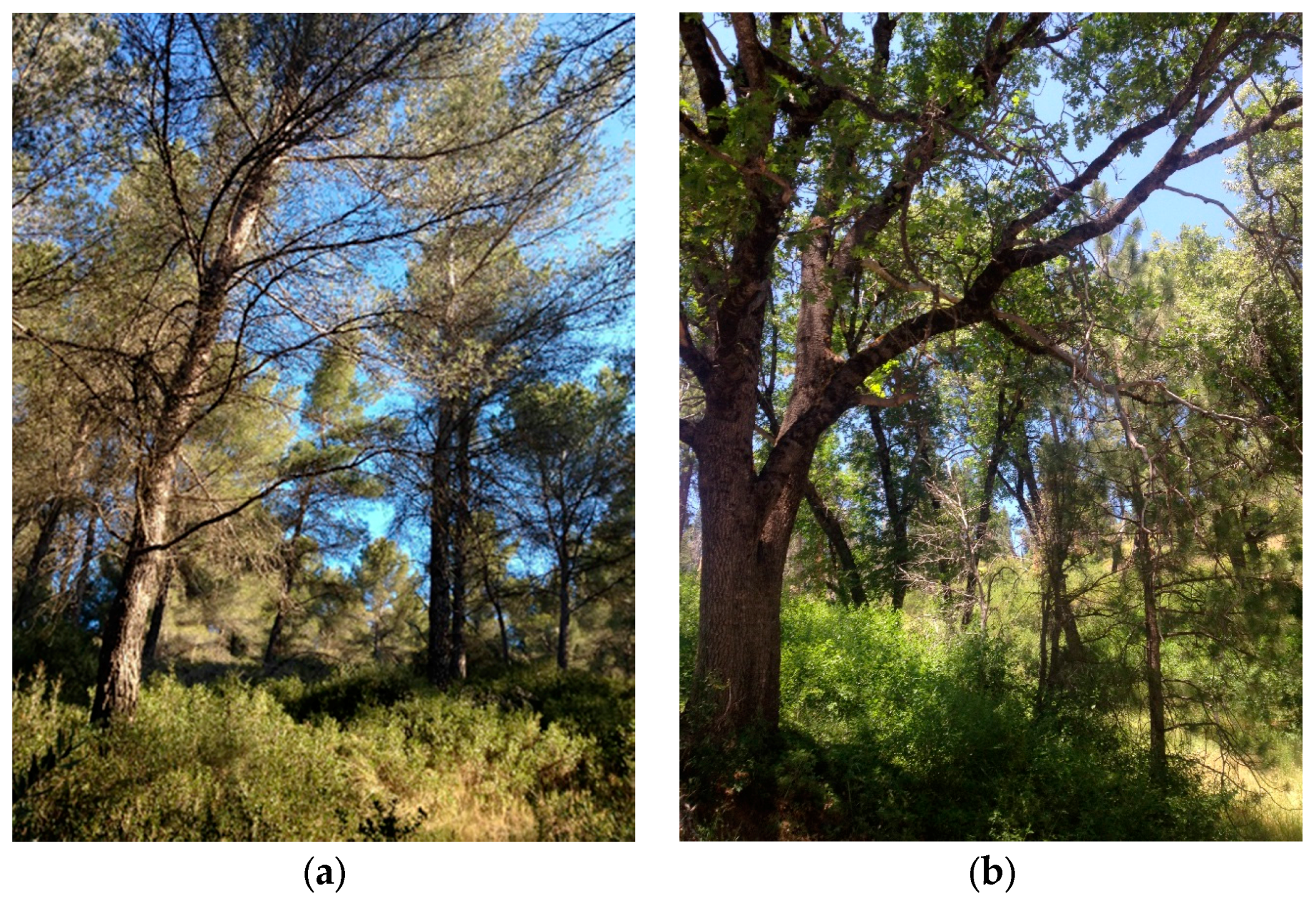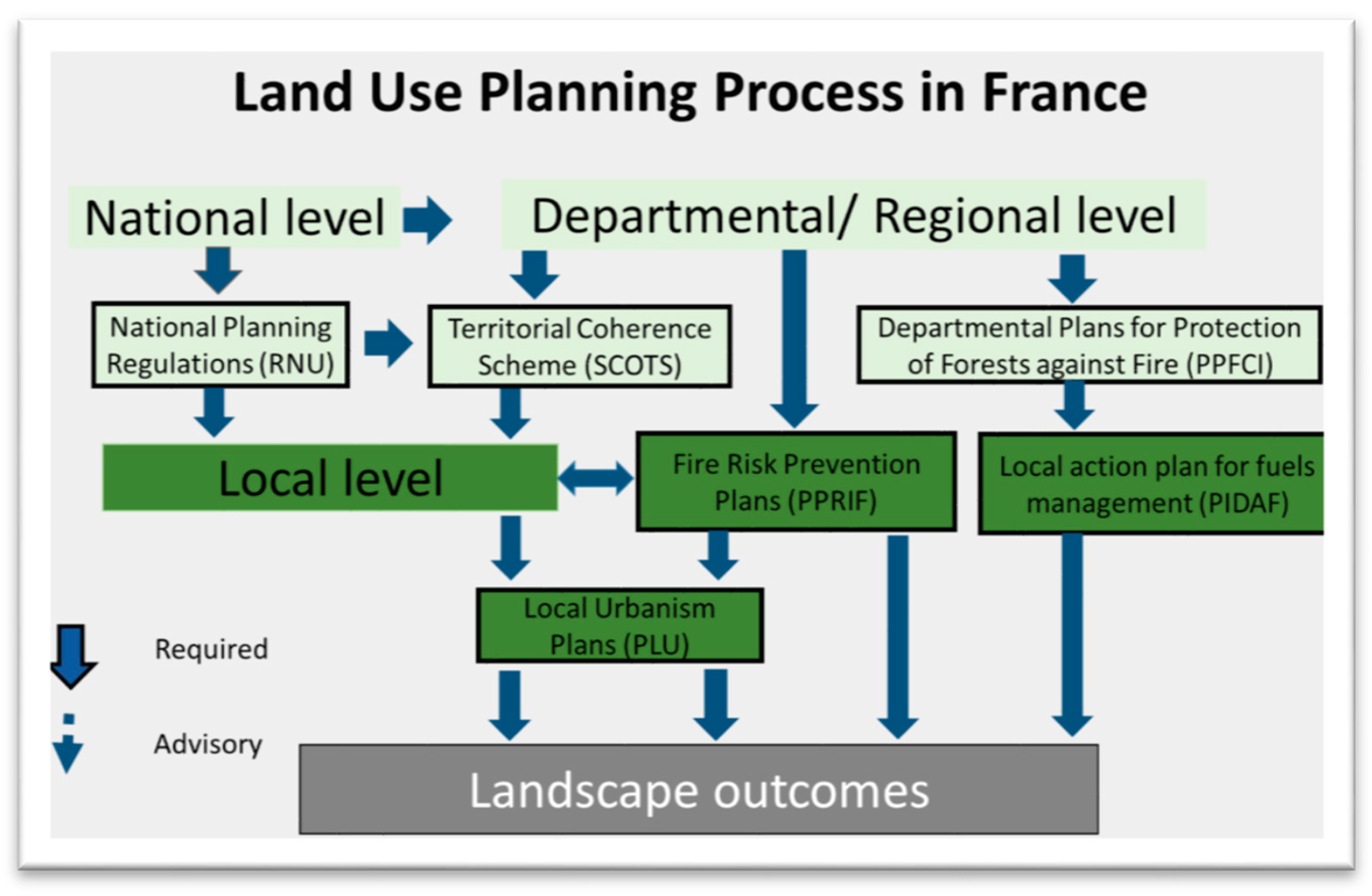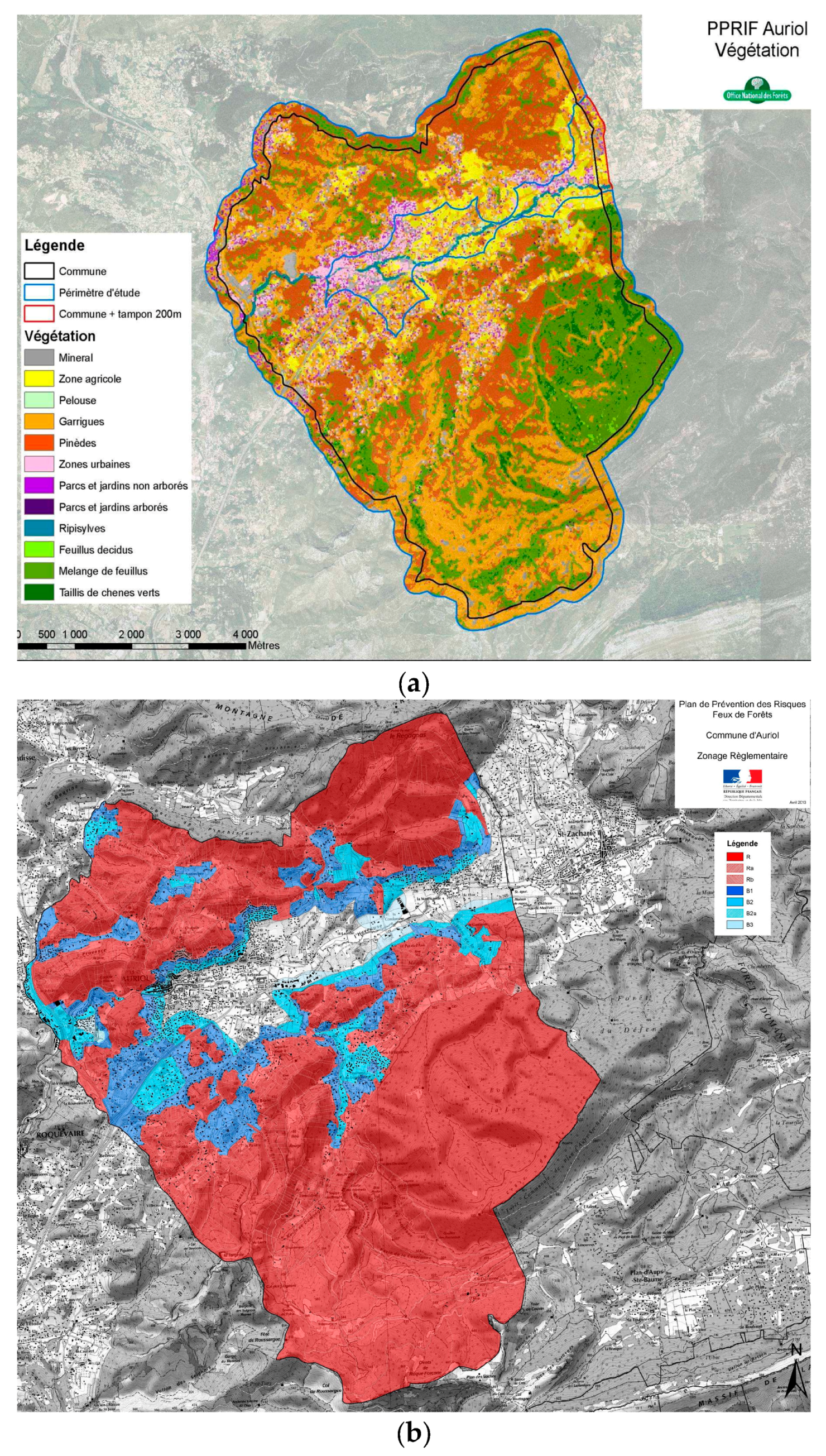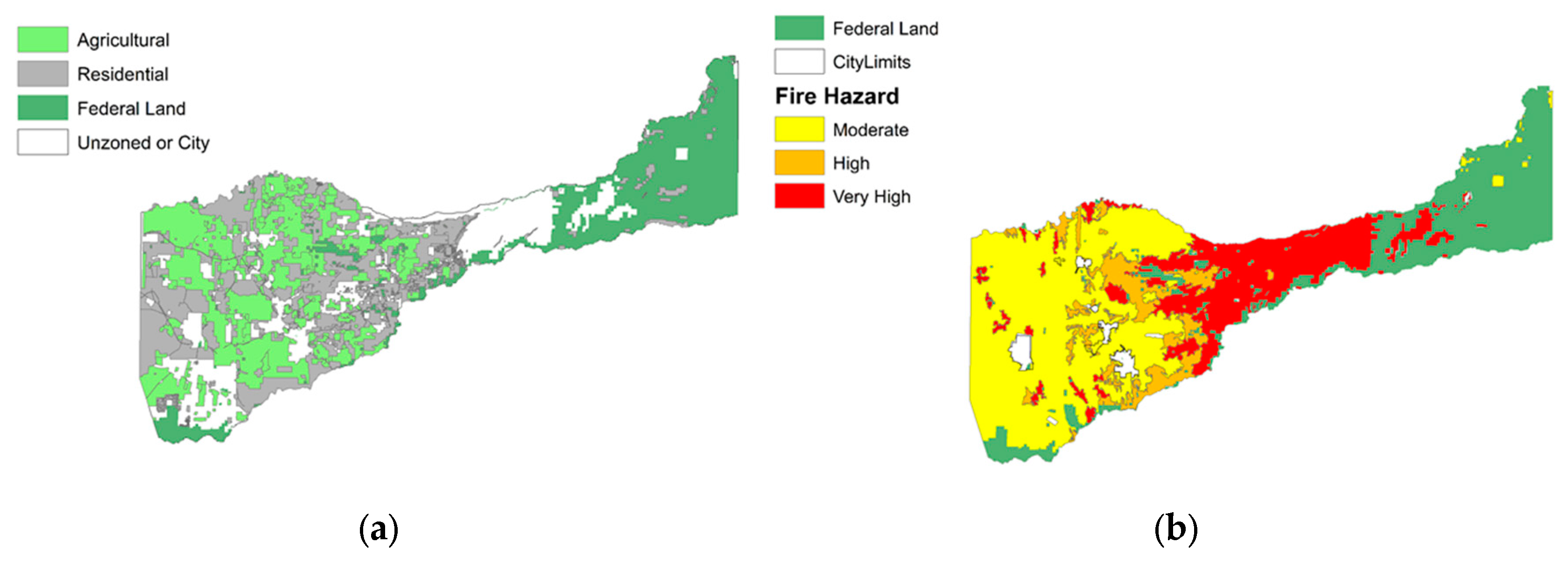Governance of Land Use Planning to Reduce Fire Risk to Homes Mediterranean France and California
Abstract
:1. Introduction
2. Materials and Methods
2.1. Study Area
2.2. Document Review and Staff Interviews
3. Results
3.1. Land Use Planning in France
3.1.1. The Role of National Government in France
3.1.2. The Role of Regional Governments
- The Red Zone, where high fire hazard makes defense of property impossible. No development is permitted.
- The Blue Zone (divided into B1, B2, and B3), where fire risk can be mitigated. Development is subject to conditions. In B1, development is allowed only if mitigation projects to reduce fire risk (including road improvement and water access) are completed. No large facilities that concentrate people such as hotels and gymnasiums are allowed and all construction must conform to fire prevention building codes. B2 zones are areas of moderate fire hazard with adequate fire defenses or where improvements can be made. New structures must be grouped and provided with wide access roads and water. B3 zones have low fire hazard with discontinuous fuels where intense fire is unlikely. These areas are subject to access and water requirements to reduce the risk of fire spreading to neighboring areas.
- The White Zone, where forest fire hazard is very low and where compliance with the general requirements of the Forest Code ensures a satisfactory level of safety. Development is allowed subject to local planning regulations.
3.1.3. The Role of Local Governments
- Urban, where new construction is permitted in existing developed and adjacent areas.
- Available for urban development, where infrastructure is already available or planned.
- Agricultural areas, where agricultural related construction is permitted.
- Protected areas with sensitive historical, ecological, or environmental values, where no new construction is permitted.
3.1.4. The Role of Citizens
3.2. Land Use Planning in California
3.2.1. The Role of National Government
3.2.2. The Role of Regional Government
3.2.3. The Role of the Local Government
3.2.4. The Role of the Citizen
4. Discussion
5. Conclusions
Acknowledgments
Author Contributions
Conflicts of Interest
References
- Brotons, L.; Aquilué, N.; de Cáceres, M.; Fortin, M.-J.; Fall, A. How fire history, fire suppression practices and climate change affect wildfire regimes in Mediterranean landscapes. PLoS ONE 2013, 8, e62392. [Google Scholar] [CrossRef] [PubMed]
- Silva, J.S.; Vaz, P.; Moreira, F.; Catry, F.; Rego, F.C. Wildfires as a major driver of landscape dynamics in three fire-prone areas of Portugal. Landsc. Urban Plan. 2011, 101, 349–358. [Google Scholar] [CrossRef]
- Pausas, J.G. Changes in Fire and Climate in the Eastern Iberian Peninsula (Mediterranean Basin). Clim. Chang. 2004, 63, 337–350. [Google Scholar] [CrossRef]
- Syphard, A.D.; Radeloff, V.C.; Keeley, J.E.; Hawbaker, T.J.; Clayton, M.K.; Stewart, S.I.; Hammer, R.B. Human influence on California fire regimes. Ecol. Appl. 2007, 17, 1388–1402. [Google Scholar] [CrossRef] [PubMed]
- Syphard, A.D.; Radeloff, V.C.; Keuler, N.S.; Taylor, R.S.; Hawbaker, T.J.; Stewart, S.I.; Clayton, M.K. Predicting spatial patterns of fire on a southern California landscape. Int. J. Wildl. Fire 2008, 17, 602–613. [Google Scholar] [CrossRef]
- Puerta-Piñero, C.; Espelta, J.M.; Sánchez-Humanes, B.; Rodrigo, A.; Coll, L.; Brotons, L. History matters: Previous land use changes determine post-fire vegetation recovery in forested Mediterranean landscapes. For. Ecol. Manag. 2012, 279, 121–127. [Google Scholar] [CrossRef]
- Fernandes, P.M. Fire-smart management of forest landscapes in the Mediterranean basin under global change. Landsc. Urban Plan. 2013, 110, 175–182. [Google Scholar] [CrossRef]
- Sturtevant, B.; Miranda, B.; Yang, J.; He, H.; Gustafson, E.; Scheller, R. Studying Fire Mitigation Strategies in Multi-Ownership Landscapes: Balancing the Management of Fire-Dependent Ecosystems and Fire Risk. Ecosystems 2009, 12, 445–461. [Google Scholar] [CrossRef]
- Syphard, A.D.; Bar Massada, A.; Butsic, V.; Keeley, J.E. Land use planning and wildfire: Development policies influence future probability of housing loss. PLoS ONE 2013, 8, e71708. [Google Scholar] [CrossRef] [PubMed]
- Syphard, A.D.; Keeley, J.E.; Massada, A.B.; Brennan, T.J.; Radeloff, V.C. Housing Arrangement and Location Determine the Likelihood of Housing Loss Due to Wildfire. PLoS ONE 2012, 7, e33954. [Google Scholar] [CrossRef] [PubMed]
- Cohen, J.; Johnson, N.; Walther, L. Saving homes from wildfires: Regulating the home ignition zone. Zoing News, May 2001; 1–5. [Google Scholar]
- Babcock, R.F. The Zoning Game: Municipal Practices and Policies; University of Wisconsin Press: Madison, WI, USA, 1969. [Google Scholar]
- Butsic, V.; Syphard, A.D.; Keeley, J.E.; Bar-Massada, A. Can private land conservation reduce wildfire risk to homes? A case study in San Diego County, California, USA. Landsc. Urban Plan. 2017, 157, 161–169. [Google Scholar] [CrossRef]
- McCaffrey, S. Thinking of Wildfire as a Natural Hazard. Soc. Nat. Resour. 2004, 17, 509–516. [Google Scholar] [CrossRef]
- Rice, C.L.; Davis, J.B. Land-Use Planning May Reduce Fire Damage in the Urban-Wildland Intermix; Gen. Tech. Rep. PSW-127; Pacific Southwest Research Station, Forest Service, U.S. Department of Agriculture: Berkeley, CA, USA, 1991; p. 13.
- Fischer, A.P.; Spies, T.A.; Steelman, T.A.; Moseley, C.; Johnson, B.R.; Bailey, J.D.; Ager, A.A.; Bourgeron, P.; Charnley, S.; Collins, B.M.; et al. Wildfire risk as a socioecological pathology. Front. Ecol. Environ. 2016, 14, 276–284. [Google Scholar] [CrossRef]
- Moritz, M.A.; Batllori, E.; Bradstock, R.A.; Gill, A.M.; Handmer, J.; Hessburg, P.F.; Leonard, J.; McCaffrey, S.; Odion, D.C.; Schoennagel, T.; et al. Learning to coexist with wildfire. Nature 2014, 515, 58–66. [Google Scholar] [CrossRef] [PubMed]
- Steelman, T.A.; Kunkel, G.F. Effective Community Responses to Wildfire Threats: Lessons From New Mexico. Soc. Nat. Resour. 2004, 17, 679–699. [Google Scholar] [CrossRef]
- Steelman, T.A.; Kunkel, G.; Bell, D. Federal and State Influence on Community Responses to Wildfire Threats: Arizona, Colorado, and New Mexico. J. For. 2004, 102, 21–28. [Google Scholar]
- Hughes, R.; Mercer, D. Planning to Reduce Risk: The Wildfire Management Overlay in Victoria, Australia. Geogr. Res. 2009, 47, 124–141. [Google Scholar] [CrossRef]
- Buxton, M.; Haynes, R.; Mercer, D.; Butt, A. Vulnerability to Bushfire Risk at Melbourne’s Urban Fringe: The Failure of Regulatory Land Use Planning. Geogr. Res. 2011, 49, 1–12. [Google Scholar] [CrossRef]
- Bhandary, U.; Muller, B. Land use planning and wildfire risk mitigation: An analysis of wildfire-burned subdivisions using high-resolution remote sensing imagery and GIS data. J. Environ. Plan. Manag. 2009, 52, 939–955. [Google Scholar] [CrossRef]
- Mann, M.L.; Berck, P.; Moritz, M.A.; Batllori, E.; Baldwin, J.G.; Gately, C.K.; Cameron, D.R. Modeling residential development in California from 2000 to 2050: Integrating wildfire risk, wildland and agricultural encroachment. Land Use Policy 2014, 41, 438–452. [Google Scholar] [CrossRef]
- Harris, L.M.; McGee, T.K.; McFarlane, B.L. Implementation of wildfire risk management by local governments in Alberta, Canada. J. Environ. Plan. Manag. 2011, 54, 457–475. [Google Scholar] [CrossRef]
- Muller, B.; Schulte, S. Governing Wildfire Risks: What Shapes County Hazard Mitigation Programs? J. Plan. Educ. Res. 2011, 31, 60–73. [Google Scholar] [CrossRef]
- Stephens, S.L.; Adams, M.A.; Handmer, J.; Kearns, F.R.; Leicester, B.; Leonard, J.; Moritz, M.A. Urban–wildland fires: How California and other regions of the US can learn from Australia. Environ. Res. Lett. 2009, 4, 14010. [Google Scholar] [CrossRef]
- Gill, A.M.; Stephens, S.L.; Cary, G.J. The worldwide “wildfire” problem. Ecol. Appl. 2013, 23, 438–454. [Google Scholar] [CrossRef] [PubMed]
- Keeley, J.E. Native American impacts on fire regimes of the California coastal ranges. J. Biogeogr. 2002, 29, 303–320. [Google Scholar] [CrossRef]
- Franklin, J.; Coulter, C.L.; Rey, S.J. Change over 70 years in a southern California chaparral community related to fire history. J. Veg. Sci. 2004, 15, 701–710. [Google Scholar] [CrossRef]
- Attiwill, P.; Binkley, D.; Ganteaume, A.; Jappiot, M. What causes large fires in Southern France. For. Ecol. Manag. 2013, 294, 76–85. [Google Scholar]
- Fernandes, P.M.; Lampin-Maillet, C.; Long-Fournel, M.; Ganteaume, A.; Jappiot, M.; Ferrier, J.P. Land cover analysis in wildland–urban interfaces according to wildfire risk: A case study in the South of France. For. Ecol. Manag. 2011, 261, 2200–2213. [Google Scholar]
- Stegen, J.C.; Freestone, A.L.; Crist, T.O.; Anderson, M.J.; Chase, J.M.; Comita, L.S.; Cornell, H.V.; Davies, K.F.; Harrison, S.P.; Hurlbert, A.H.; et al. Stochastic and deterministic drivers of spatial and temporal turnover in breeding bird communities. Glob. Ecol. Biogeogr. 2013, 22, 202–212. [Google Scholar] [CrossRef]
- Booth, P. Decentralization and land use planning in France: A 15 year review. Policy Politics 1998, 26, 89–105. [Google Scholar] [CrossRef]
- Jacobs, H.M. Who Owns America; University of Wisconsin Press: Madison, WI, USA, 1998. [Google Scholar]
- Keeley, J.E.; Bond, W.J.; Bradstock, R.A.; Pausas, J.G.; Rundel, P.W. Fire in Mediterranean Ecosystems: Ecology, Evolution and Managment; Cambridge University Press: Cambridge, UK, 2011. [Google Scholar]
- Woodward, J.C. The Physical Geography of the Mediterranean; Oxford University Press: Oxford, UK, 2009. [Google Scholar]
- Pyne, S.J. Vestal Fire: An Environmental History, Told through Fire, of Europe and Europe’s Encounter with the World; University of Washington Press: Seattle, WA, USA, 1997. [Google Scholar]
- Whited, T.L. Extinguishing disaster in Alpine France: The fate of reforestation as technocratic debacle. GeoJournal 2000, 51, 263–270. [Google Scholar] [CrossRef]
- Vallauri, D.R.; Aronson, J.; Barbero, M. An Analysis of Forest Restoration 120 Years after Reforestation on Badlands in the Southwestern Alps. Restor. Ecol. 2002, 10, 16–26. [Google Scholar] [CrossRef]
- Velez, R. The causing factors: A focus on economic and social driving forces. In Living with Wildfires, What Science Can Tell Us: A Contribution to the Science; Briot, Y., Ed.; European Forest Institute, Mediterranean Regional Office: Barcelona, Spain, 2009; p. 78. [Google Scholar]
- Bassi, S.; Kettunen, M.; Kampa, E.; Cavalieri, S. Forest Fires: Causes and Contributing Factors to Forest Fire Events in Europe; Study for the European Parliament Committee on Environment. Public Health and Food Safety under contract IP/A/ENVI/ST/2007-15 PE 401.003; Institute for European Environmental Policy: Brussels, Belgium, 2008. [Google Scholar]
- Van Stralen, D.; Provansal, G. The French Connection: French wildland fire fighters find success through high reliability concepts. Wildl. Firef. 2007, 26–34. [Google Scholar]
- Stephens, S.L.; Martin, R.E.; Clinton, N.E. Prehistoric fire area and emissions from California’s forests, woodlands, shrublands, and grasslands. For. Ecol. Manag. 2007, 251, 205–216. [Google Scholar] [CrossRef]
- Kocher, S.; Beckwitt, S. Forest Health and Carbon Storage; System Indicators. A report to the Sierra Nevada Conservancy, Auburn, California 2012. Available online: http://www.sierranevada.ca.gov/our-region/sys_ind_docs/SystetmIndicatorsForestHealth.pdf (accessed on 30 March 2017).
- Pincetl, S. Transforming California, The Political History of Land Use and Developemnt, 1st ed.; Johns Hopkins University Press: Baltimore, MD, USA, 2003. [Google Scholar]
- Wagtendonk, J.W.V. The History and Evolution of Wildland Fire Use. Fire Ecol. 2007, 3, 3–17. [Google Scholar] [CrossRef]
- Hammer, R.B.; Radeloff, V.C.; Fried, J.S.; Stewart, S.I. Wildland–urban interface housing growth during the 1990s in California, Oregon, and Washington. Int. J. Wildl. Fire 2007, 16, 255–265. [Google Scholar] [CrossRef]
- Radeloff, V.; Hammer, R.; Stewart, S.; Fried, J.; Holcomb, S.; McKeefry, J. The wildland-urban interface in the United States. Ecol. Appl. 2005, 15, 799–805. [Google Scholar] [CrossRef]
- Dolanc, C.R.; Safford, H.D.; Thorne, J.H.; Dobrowski, S.Z. Changing forest structure across the landscape of the Sierra Nevada, CA, USA, since the 1930s. Ecosphere 2014, 5, 1–26. [Google Scholar] [CrossRef]
- Steel, Z.L.; Safford, H.D.; Viers, J.H. The fire frequency-severity relationship and the legacy of fire suppression in California forests. Ecosphere 2015, 6, 1–23. [Google Scholar] [CrossRef]
- State of California General Plan Guidelines. Available online: https://www.opr.ca.gov/s_generalplanguidelines.php (accessed on 12 May 2016).
- State of California FRAP—Wildfire Hazard Real Estate Disclosure. Available online: http://frap.fire.ca.gov/projects/hazard/hazard (accessed on 12 May 2016).
- Alex, K.; Morgan, S.; Rubin, B.; Calfee, C.; Glover, N. Fire Hazard Planning General Plan Technical Advice Series; Governor’s Office of Planning and Research: Sacramento, CA, USA, 2014.
- State of California Fire Prevention Fee. Available online: http://www.firepreventionfee.org/ (accessed on 12 May 2016).
- State Board of Forestry and Fire Protection, California Department of Forestry and Fire Protection. 2010 Strategic Fire Plan for California. Available online: http://cdfdata.fire.ca.gov/pub/fireplan/fpupload/fpppdf668.pdf (accessed on 30 March 2017).
- Forest and Rangelands National Cohesive Wildland Fire Management Strategy. Available online: https://www.forestsandrangelands.gov/strategy/ (accessed on 16 October 2016).
- National Oceanic and Atmospheric Administration Endangered Species Act. Available online: http://www.nmfs.noaa.gov/pr/laws/esa/ (accessed on 1 January 2015).
- Forest and Rangeland Community Wildfire Protection Plan (CWPP). Available online: https://www.forestsandrangelands.gov/communities/cwpp.shtml (accessed on 12 October 2016).
- Federal Emergency Management Agency Local Mitigation Planning Handbook | FEMA.gov. Available online: https://www.fema.gov/media-library/assets/documents/31598 (accessed on 30 March 2017).
- U.S. Forest Service The National Fire Plan. Available online: https://www.forestsandrangelands.gov/resources/overview/ (accessed on 16 October 2016).
- Butsic, V.; Kelly, M.; Moritz, M. Land Use and Wildfire: A Review of Local Interactions and Teleconnections. Land 2015, 4, 140–156. [Google Scholar] [CrossRef]
- Bouisset, C. PPR, Urbanization and Forest Fire Risks in Pyrénées-Orientales Department: Methods, Issues, Debates. Available online: http://cybergeo.revues.org/24658 (accessed on 30 March 2017).
- Carr, M.; Stein, S. Across the Green Line: How Forest Service Employees Can Support Local Land Use Planning Efforts; FS-1021; Department of Agriculture (USDA), Forest Service: Washington, DC, USA, 2014; p. 36.
- Rhone Delta Department Porter à Connaissance du Risque Incendie de Forêt/La Prévention/Sécurité Civile/Sécurité/Politiques Publiques/Accueil—Les Services de l’État dans le Département des Bouches-du-Rhône. Available online: http://www.bouches-du-rhone.gouv.fr/Politiques-publiques/Securite/Securite-civile/La-prevention/Porter-a-Connaissance-du-risque-incendie-de-foret (accessed on 13 February 2017).
| 1 | France is divided into regions, which are then divided into a total of 96 departments. They are similar to counties within American states. |
| 2 | Departments are divided into communes, which are similar to US townships. There are about 36,000 in France. |





| Country/State | Population (Millions 2013) | Area (km2) | Density (Persons/km2 2013) | % Forest | % of Total Forest Land Ownership | Area Burned Annually (km2 2010–2015) | Largest Fires (km2) | Largest Structure Loss Due to Fire (# Structures) | |
|---|---|---|---|---|---|---|---|---|---|
| Public | Private | ||||||||
| France | 66 | 643,801 | 121 | 31% | 26% | 74% | 84 | ||
| Mediterranean France | 8.8 | 155,540 | 57 | 38% | 28% | 72% | 40 | 614 for all 2003 fires | <10 per year from all fires * |
| California | 39 | 423,971 | 97 | 33% | 60% | 40% | 2126 | 1106 in 2003 Cedar Fire | 3280 in 1991 Oakland hills fire |
| Sierra Nevada | 0.8 | 98,819 | 8 | 43% | 71% | 29% | 931 | 1012 in 2013 Rim Fire | 921 in 2015 Butte fire |
© 2017 by the authors. Licensee MDPI, Basel, Switzerland. This article is an open access article distributed under the terms and conditions of the Creative Commons Attribution (CC BY) license (http://creativecommons.org/licenses/by/4.0/).
Share and Cite
Kocher, S.D.; Butsic, V. Governance of Land Use Planning to Reduce Fire Risk to Homes Mediterranean France and California. Land 2017, 6, 24. https://doi.org/10.3390/land6020024
Kocher SD, Butsic V. Governance of Land Use Planning to Reduce Fire Risk to Homes Mediterranean France and California. Land. 2017; 6(2):24. https://doi.org/10.3390/land6020024
Chicago/Turabian StyleKocher, Susan D., and Van Butsic. 2017. "Governance of Land Use Planning to Reduce Fire Risk to Homes Mediterranean France and California" Land 6, no. 2: 24. https://doi.org/10.3390/land6020024







